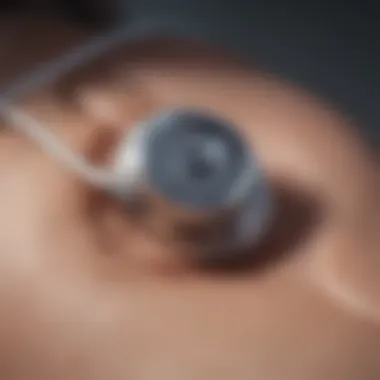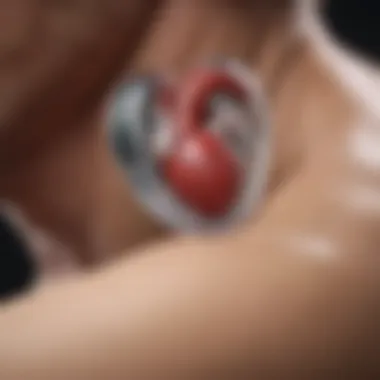Exploring the Heartbeat Listening Device: Innovations and Uses


Intro
The heartbeat listening device plays a crucial role in understanding cardiovascular health. This article examines its evolution, innovations, and several applications across different fields. As technology advances, these devices have transformed patient care and how health professionals monitor cardiac rhythms. This piece aims to highlight the fundamental principles behind these devices, innovative progress that enhances their effectiveness, and the various contexts in which they are applied.
Research Overview
The developing landscape of cardiac monitoring devices provides a rich domain for scientific inquiry. Understanding how these devices operate is essential for researchers and health professionals alike.
Summary of Key Findings
The primary findings emphasize:
- The historical context of heartbeat listening technology, showing its growth from rudimentary instruments to advanced digital devices.
- Innovations such as remote monitoring, mobile applications, and integration with artificial intelligence that broaden the scope of usability.
- Applications in diverse settings, including hospitals, telemedicine, and home-based care, revealing substantial benefits for patients.
Research Objectives and Hypotheses
This research intends to clarify how heartbeat listening devices measure cardiac rhythms effectively. It aims to establish how advancements in technology contribute to improved patient outcomes. The hypothesis posits that enhanced accuracy and functionality will lead to better diagnostics, thereby fostering timely medical interventions.
Methodology
To effectively explore these concepts, a rigorous methodology was employed.
Study Design and Approach
A descriptive qualitative approach was adopted. This allowed for detailed analysis of existing literature, technological improvements, and clinical applications. The study synthesized information from academic journals, industry reports, and interviews with experts in the field.
Data Collection Techniques
Data was collected through various methods:
- Literature Review: An extensive review of academic articles and reports on heartbeat listening devices.
- Interviews: Conversations with industry specialists in cardiac technology that provided insights on current trends.
- Case Studies: Analysis of real-world applications and their impacts on patient monitoring.
Innovations in heartbeat listening devices can enhance patient monitoring significantly, leading to improved healthcare interventions.
Foreword to Heartbeat Listening Devices
The concept of heartbeat listening devices has earned significant importance in contemporary medical science. These devices are critical in the accurate measurement and interpretation of cardiac rhythms, contributing substantially to patient care. Understanding heartbeat listening devices is essential, as they represent the intersection of technology and healthcare, enhancing quality of life and improving clinical outcomes.
Definition and Historical Context
Heartbeat listening devices, often categorized under cardiac monitoring tools, include a range of instruments designed to detect and analyze heartbeats. The earliest form of these devices can be traced back to traditional stethoscopes, which enabled physicians to listen to internal sounds of a patient’s body.
The historical context reveals that the development of these devices has evolved alongside medical advancements. In the late 19th century, tools progressed from mere listening instruments to more complex machines capable of recording and displaying heart activity. This advancement marked a pivotal point in the history of cardiovascular health monitoring.
Evolution of Cardiovascular Monitoring
Over the decades, cardiovascular monitoring has significantly evolved. Initial systems were bulky and limited in their ability to provide precise data. However, with the advent of electronic technologies in the mid-20th century, real-time cardiac monitoring began to take shape.
Modern devices now utilize sophisticated algorithms to interpret heartbeats with remarkable accuracy. The introduction of pulse oximeters and ECG monitors revolutionized monitoring, providing vital signs that could be conveyed remotely. Today, integrated systems featuring wearable technology and smartphone applications are becoming commonplace, allowing continuous monitoring of heart health.
Additionally, the integration of artificial intelligence into these devices enhances diagnostic efficiency and efficacy. This progression reflects a broader trend toward personalized healthcare, where monitoring can be adapted to meet the unique needs of individual patients.
From simple auditory assessments to advanced monitoring systems, the evolution of heartbeat listening devices illustrates the significant strides made in cardiovascular monitoring. These innovations not only improve clinical practice but also empower patients in managing their own health.


Fundamental Principles of Operation
Understanding the fundamental principles of operation for heartbeat listening devices is crucial for grasping their significance in medical diagnostics and monitoring. These principles form the backbone of how these devices function and ultimately impact patient care and outcomes. The primary focus resides in the intricate relationship between sound waves and cardiovascular signals. This section elucidates the core concepts that underpin these devices, ensuring that readers appreciate the technological advancements and their implications in clinical settings.
Acoustic Principles and Sound Wave Propagation
The realm of acoustic principles in relation to heartbeat listening devices revolves around how sound waves travel through various mediums. When detecting cardiac activity, specific frequencies and waveforms that represent heartbeats are captured. These acoustic signals are derived from the mechanical movement of the heart and blood flow through the arteries.
In essence, two main types of sounds are relevant: the first is the direct sound generated by the heart's contractions, while the second includes the sounds produced by blood flow. Both types contribute to the overall auditory experience a clinician interprets through the device. Effective propagation of these sound waves depends on various factors, including the medium's density, temperature, and viscosity. Understanding these properties allows for advancements in device design, improving the clarity and reliability of the acquired signals.
Important considerations in this context include:
- The frequency range that can be effectively captured by the device.
- The potential for noise interference from external sources.
- Methods to enhance signal-to-noise ratios.
Integrating advanced acoustic techniques can significantly improve the precision of heartbeat detection and analysis.
Sensor Technologies: Types and Mechanisms
Sensor technology encompasses a broad spectrum of devices utilized for capturing cardiac signals and translating them into readable data. Among the most notable types of sensors are piezoelectric, electromagnetic, and optical sensors. Each of these technologies has specific mechanisms that dictate how they operate and interact with biological systems.
- Piezoelectric sensors exploit materials that generate an electric charge in response to mechanical stress, making them highly effective in capturing the subtle vibration associated with heartbeats.
- Electromagnetic sensors, on the other hand, detect changes in electromagnetic fields caused by heart activity, offering a non-invasive approach to monitoring cardiac function.
- Optical sensors utilize light to assess blood volume changes with each heartbeat, allowing for continuous monitoring without the need for physical contact.
Factors influencing the choice of sensor include:
- Sensitivity: The ability to detect minor changes in cardiac signals.
- Accuracy: Minimal deviation from actual heart rhythms is paramount for clinical relevance.
- Longevity: Considerations around how long a device can function before requiring replacement or recalibration are critical in a healthcare setting.
Advances in sensor technologies are crucial for enhancing diagnostic capabilities. Each innovation represents a step towards more reliable cardiac monitoring.
Technological Innovations in Heartbeat Monitoring
Technological innovations have drastically changed heartbeat monitoring. These advancements not only enhance the precision of cardiac data but also broaden the scope of their applications. The integration of technology into heart monitoring enables real-time data transmission and extensive patient reach beyond conventional settings. This section will explore several aspects: wearable technology, artificial intelligence, and advancements in sensor accuracy and sensitivity.
Wearable Technology and Mobile Applications
Wearable technology has made significant inroads into heart monitoring. Devices like the Apple Watch and Fitbit can track users’ heart rates continuously. Unlike traditional heart rate monitors, these wearables allow for real-time data collection and act as proactive health guardians.
Mobile applications complement these devices. They analyze data and often provide health insights. Patients can receive alerts for abnormal heart rates or irregular rhythms. The data can be shared with healthcare providers, creating a seamless communication channel for managed care. For optimal use, users should consider:
- Ease of Use: The interface should be intuitive for engagement.
- Battery Life: Longer battery life ensures continuous monitoring.
- Data Security: Protection against unauthorized access is crucial.
Integration with Artificial Intelligence
Artificial Intelligence (AI) is increasingly integrated into heartbeat monitoring technology. AI algorithms analyze vast datasets, enhancing prediction capabilities for cardiac events. This integration allows for:
- Predictive Analytics: Identifying at-risk patients by assessing previous data trends.
- Personalized Care: Tailoring health recommendations based on individual patterns.
- Data Processing: Aiding clinicians by processing data efficiently, identifying anomalies faster.
AI's role in real-time monitoring cannot be overstated. By leveraging machine learning, systems can adapt based on newly collected data, optimizing outcomes while minimizing human error.
Advancements in Sensor Accuracy and Sensitivity
Sensor technology is fundamental in heartbeat listening devices. Recent developments have led to increased accuracy and sensitivity in these sensors. Modern sensors can detect even minor fluctuations in heart activity. This leads to improved diagnosis and patient monitoring. Key advancements include:
- Miniaturization: Smaller sensors allow for discreet monitoring without compromising performance.
- Multi-parameter Monitoring: New sensors can measure additional parameters like oxygen levels, providing a more comprehensive view of cardiovascular health.
- Remote Monitoring Capabilities: High-sensitivity sensors can relay data from patients in real time, facilitating timely medical responses.


The convergence of these innovations is laying the foundation for future developments in heartbeat monitoring, contributing positively to patient care and outcomes. As technology rapidly evolves, the prospects for improving cardiac health appear promising.
Applications in Clinical Practice
The applications of heartbeat listening devices in clinical practice are transformative. They influence how healthcare providers monitor, diagnose, and treat cardiovascular conditions. The increased adoption of these devices has created a paradigm shift in patient care management, emphasizing the need for real-time monitoring and proactive health management. This section explores three key areas where these devices are particularly impactful: remote patient monitoring and telemedicine, use in emergency medicine, and their educational purposes in cardiac training.
Remote Patient Monitoring and Telemedicine
Remote patient monitoring has revolutionized how healthcare is delivered. By utilizing heartbeat listening devices, patients can be monitored from their homes. This offers significant advantages:
- Accessibility: Patients in rural or underserved areas gain access to specialist care that was once unavailable.
- Continuous Monitoring: Devices can transmit real-time data, enabling healthcare providers to track patients' heart health continuously and intervene when necessary.
- Patient Engagement: Patients are more involved in their health, improving adherence to treatment plans.
The combination of telemedicine and these devices enhances efficiency. It reduces hospital visits, lowering both costs and risks of infections. Remote monitoring also frees up time for healthcare providers to concentrate on critical cases, promoting better patient outcomes.
Use in Emergency Medicine
In emergency medical situations, timely access to accurate heart rate data can mean the difference between life and death. Heartbeat listening devices aid in several ways:
- Rapid Assessment: First responders can quickly assess a patient's condition on-site, aiding in decisive and immediate treatment approaches.
- Data Transmission: Information can be sent to hospitals before a patient arrives, preparing the medical team for immediate intervention upon arrival.
- Guiding Treatment Decisions: Continuous access to heart rhythm data helps in understanding the patient's status and guiding medication or procedure decisions in real time.
Such capabilities are crucial in emergencies like cardiac arrests, where quick and accurate decision-making is vital.
Educational Purpose in Cardiac Training
Heartbeat listening devices serve not only practical applications but educational ones too. Medical training programs increasingly incorporate these technologies to provide:
- Hands-On Experience: Students can learn how to use devices and interpret data accurately.
- Simulation Training: Real-life scenarios enhance their ability to respond under pressure.
- Interdisciplinary Learning: These devices promote collaboration between cardiology, nursing, and technology students, creating a more holistic understanding of patient care.
Innovative educational methodologies, by integrating these devices, prepare the next generation of healthcare professionals for the challenges of modern cardiovascular care.
In summary, heartbeat listening devices enhance clinical practices profoundly. They not only improve patient monitoring and emergency responses but also serve as a critical educational tool in healthcare training.
Challenges and Limitations
In any field, understanding the challenges and limitations of the adopted technologies is crucial for effective application and improvement. In the case of heartbeat listening devices, recognizing these challenges helps us enhance their design and utility. Addressing technical limitations and ethical considerations presents opportunities for better patient outcomes and technological advancements.
Technical Limitations of Current Devices
Heartbeat listening devices, though revolutionary, are not free from technical shortcomings. Some notable issues include:
- Signal Interference: Environmental factors can affect the accuracy of readings. Objects that produce noise or electromagnetic interference can disrupt sensor performance.
- Battery Life: Many wearable devices struggle with battery longevity. Frequent charging is needed, which can limit consistent monitoring and user compliance.
- Space and Size Restrictions: The compact nature of these devices can sometimes compromise sensor output and data resolution. Smaller sensors might not capture a full range of physiological data.
- Limited Data Analysis Capabilities: While some devices provide heart rhythm data, they may lack the analytical capability to derive meaningful insights or alerts effectively.
These limitations can hinder effective patient monitoring, reducing confidence in long-term use. Continuous research is needed to advance these technologies and overcome such hurdles.
Ethical Considerations in Use
As heartbeat listening devices become more integrated into healthcare, ethical considerations take on significant importance. Some points of concern include:
- Data Privacy: With data collection comes the risk of unauthorized access. Ensuring patient confidentiality remains a priority in device design and operation.
- Informed Consent: Before utilizing these devices, patients should understand how their data will be used. Clarity is necessary to foster trust in technological solutions.
- Equity in Access: Not all patients have equal access to advanced heartbeat monitoring devices. This disparity may exacerbate existing healthcare inequalities.
"The integration of technology in healthcare necessitates a careful balance between innovation and patient rights."
Addressing these ethical issues is essential for fostering a responsible healthcare environment where patient-centric practices reign. Awareness and deliberate strategies can help mitigate these challenges, ultimately leading to improved outcomes for both patients and healthcare providers.


Future Trends in Heartbeat Listening Technology
The field of heartbeat listening devices is rapidly evolving, driven by technological advancements and the increasing emphasis on personalized healthcare. Future trends are set to redefine the way we monitor cardiovascular health. They promise enhanced accuracy, better integration with other healthcare technologies, and improved patient outcomes. This section explores the emerging technologies and the integration of big data in cardiac health, offering a glimpse into what the future holds for heartbeat monitoring devices.
Emerging Technologies and Their Potential
Emerging technologies play a crucial role in revolutionizing heartbeat listening devices. These innovations are not just incremental improvements; they potentially change the entire landscape of cardiac monitoring. Notable developments include:
- Wearable Devices: Companies like Apple and Fitbit are at the forefront, creating smartwatches that not only track heart rates but also perform ECGs. These handheld devices offer real-time insights into users’ cardiac conditions, empowering individuals to take charge of their health.
- Non-Invasive Sensors: New kinds of sensors can now capture heart rhythms without the need for invasive procedures. Technologies utilizing optical coherence tomography (OCT) and ultrasound are becoming more prevalent. These methods provide high-resolution images of heart structures, enabling precise monitoring of heart health.
- Nanotechnology: Miniaturization through nanotechnology allows us to develop sensors that are smaller yet more effective. Future devices will likely be seamless, easily integrated into daily attire without compromising comfort or convenience.
As these technologies emerge, the focus shifts toward enhancing user experience and reliability of data gathered.
The Role of Big Data in Cardiac Health
Big data is reshaping various sectors, and cardiac health is no exception. With the rise of the Internet of Things (IoT), countless devices generate vast amounts of data. This section outlines how big data contributes to heartbeat listening technology:
- Predictive Analytics: By processing data from multiple sources, healthcare professionals can identify patterns and predict potential cardiovascular issues. Predictive analytics help in offering personalized medical recommendations, leading to preventive measures.
- Comprehensive Data Analysis: Machine learning algorithms process collected data efficiently, deriving meaningful insights. This capability allows for the detection of abnormal patterns in heart rhythms that may be overlooked.
- Population Health Monitoring: Analyzing data from large populations leads to better understanding of heart diseases and their risk factors. This information is invaluable for public health initiatives and resource allocation.
"The synthesis of big data with cardiac health monitoring will allow for not only better individual care but also broader public health benefits."
Overall, the convergence of new technologies and big data creates a promising landscape for the future of heartbeat listening devices. The potential to prevent, diagnose, and treat heart-related conditions more effectively makes this a critical area of focus for researchers and healthcare providers alike.
Impact on Patient Outcomes
The impact of heartbeat listening devices extends beyond mere cardiac monitoring. Their significance in healthcare largely revolves around improving patient outcomes. These devices facilitate spectacular advances in patient care by offering continuous monitoring, which leads to prompt interventions. Immediate access to cardiac data enables healthcare providers to make informed decisions, ultimately leading to better patient management and outcomes.
Increased accessibility to heartbeat listening devices also plays a crucial role. Devices like wearable monitors provide individuals the ability to track their heart health outside of clinical settings. This promotes greater patient awareness and proactive health management. Such technology generates a wealth of data that can be leveraged to interpret varied heart conditions, making it an essential component of modern healthcare.
Case Studies and Evidence-Based Findings
Numerous case studies underline the efficacy of heartbeat listening devices in various medical contexts. For instance, institutions have recorded significant results from using these devices for remote patient monitoring during the COVID-19 pandemic. A study revealed that patients using such devices had a reduction in emergency room visits due to timely interventions based on the transmitted data. These findings illustrate how continuous heart rate tracking can prevent serious complications by allowing for earlier treatment.
Another example can be drawn from cardiac rehabilitation programs. Patients using heartbeat monitors during exercise programs not only adhered better to their therapeutic routines but also reported improved recovery times. Data from multiple rehabilitation centers showed that patients who were regularly monitored through these devices had a 30% higher improvement rate in cardiovascular fitness compared to those without such monitoring.
Long-term Monitoring and Its Benefits
The long-term benefits of heartbeat listening devices cannot be overstated. Consistent monitoring allows for the identification of irregularities or patterns over time, helping physicians devise better treatment plans. For patients with chronic conditions, continuous data tracking translates into better medication management. It helps in determining the effectiveness of a particular treatment and adjusting strategies as needed.
Regular monitoring also provides a psychological benefit. Knowing that one’s heart health is being monitored can reduce anxiety about potential heart issues. Patients often feel empowered and more engaged in their health care process. This engagement can foster adherence to treatment regimens and positively influence overall health outcomes.
"The integration of heartbeat listening devices not only enhances patient management but also transforms the patient experience towards a more informed and proactive model of care."
In summary, the impact of heartbeat listening devices on patient outcomes is profound. They enable timely interventions, enhance patient engagement, and improve overall health management. As these devices become more ubiquitous in healthcare settings, their potential to improve patient outcomes will only continue to grow.
The End
The conclusion of this article serves as a critical reflection on the rich tapestry of developments surrounding heartbeat listening devices. It encapsulates the progression from basic monitoring tools to sophisticated systems integrated into healthcare practices. Understanding this evolution is crucial for appreciating the current advantages and potential future enhancements in cardiovascular monitoring technology.
Recap of Key Points
To summarize the core insights gleaned from the article:
- Historical Context: Heartbeat listening devices have evolved significantly, with their origins rooted in basic acoustic monitoring to advanced digital technologies.
- Technological Innovations: Advances in wearable tech, mobile applications, and AI integration have transformed how cardiac rhythms are tracked and analyzed.
- Clinical Applications: These devices are essential in remote patient monitoring, emergency medical responses, and medical training settings.
- Challenges: Though beneficial, there are limitations concerning device accuracy and ethical implications that must be addressed.
- Future Directions: Continuous advancements, such as the incorporation of big data, promise to further enhance patient care and predictive analytics in cardiac health.
Final Thoughts and Future Directions
The journey of heartbeat listening devices is ongoing. The increased emphasis on remote monitoring highlights their significance in modern healthcare. Bridging gaps in accessibility and efficiency remains an expansive area for exploration.
"The future of healthcare lies in our ability to integrate technology effectively into patient care, demonstrating the need for continuous learning and adaptation."
Ultimately, the heartbeat listening device stands as a testament to the remarkable intersection of technology and medicine, forging pathways for a healthier future.















